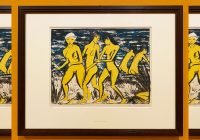Impressionismus im Museum Barberini
Von Holger Jacobs
11.09.2020
Einer der größten Sammlungen mit der Kunst aus der Zeit des Impressionismus ist jetzt im Museum Barberini als Dauerausstellung zu sehen.
Kunstsammler Hasso Plattner, Gründer und langjähriger Vorstandsvorsitzender der Softwarefirma SAP, begann bereits vor vielen Jahren eine umfangreiche Kunstsammlung aufzubauen. Schwerpunkt: Impressionismus.
Der Kunstmäzen, der, laut Forbes-Liste von 2018, mit 12 Milliarden Euro einer der reichsten Deutschen, hatte zuletzt noch im November 2016 das Gemälde „Meules“ (Getreideschober) von Claude Monet bei Christie’s in New York für 110 Millionen US-Dollar (ca. 92 Millionen Euro) gekauft. Auch diese Arbeit hängt jetzt in der Ausstellung als eines der Highlights der Sammlung.
Warum ist der Impressionismus so beliebt?
Wie ich schon zur Ausstellung „Im – Ex Impressionismus Expressionismus“ im Alten Museum 2015 feststellte, ist der Malstil des Impressionismus, der sich in Frankreich Mitte des 19. Jahrhunderts entwickelte, bei fast allen Menschen gleich beliebt. Egal welcher Herkunft, welches Geschlecht, welche Hautfarbe, und welcher kulturelle Hintergrund.
Ich bin kein Kunstwissenschaftler, aber ich denke, dass mit den Bildern der Impressionisten ein ganz bestimmtes positives Lebensgefühl vermittelt wird. Die Bilder drücken eine Freude aus, die die Maler bei der Entstehung ihrer Werke selber gefühlt haben müssen.
Schönheit und Freude ist eine sehr besondere Paarung. Bringt sie uns doch weit hinaus aus unserem Alltagsleben und lässt uns träumen von Momenten voller Lebenslust. Genau dies ist es, was die Impressionisten mit ihren Bildern bei uns erreichen.
Mein Video zeigt die Ausstellung in 2.14 Minuten:
Viele Kunstrichtungen haben hohe technische, manchmal intellektuelle und häufig auch religiöse Ziele. Genaue Darstellung der Wirklichkeit, außergewöhnliche Perspektiven oder auch nie dagewesene Farbmischungen machten so einige der alten Meister in Italien, Frankreich und den Niederlanden berühmt. Doch all das interessierte die Impressionisten nicht. Sie wollten den Augenblick festhalten, der durch Licht und Farben ihr Herz erfüllte.
Diesen Moment des Glücks galt es festzuhalten.
Das ist der Grund dafür, dass bis heute alle Menschen die Kunst der Impressionisten so lieben – egal, ob als Kunstexperte oder Amateur.
Kein Wunder also, dass auch Hasso Plattner sich in diese Bilder verliebt hat. Das Problem ist nur, dass es von diesen Malern kaum Bilder zu erwerben gibt. Entweder sind sie in Sammlungen großer Museen, oder sie sind so teuer, dass sich ein Normalbürger sie nie leisten könnte.
Die Seltenheit impressionistischer Werke auf dem Kunstmarkt führte dazu, dass Hasso Plattner gut 20 Jahre seines Lebens brauchte, um immerhin 103 Gemälde aus dieser Zeit zu erwerben. Sie sind jetzt alle in dieser Ausstellung zu sehen.
In der Sammlung gibt es sowohl weniger bekannte, als auch sehr berühmte Künstler ihrer Zeit.
Allein von dem Maler Claude Monet, vielleicht der bekannteste unter ihnen, besitzt Hasso Plattner 35 Arbeiten, die größte Sammlung von Monet’s in privater Hand.
Das bis jetzt letzte, der Getreideschober („Meules“), wie schon oben erwähnt, kam dann 2019 hinzu. Es ist die Nummer 11 auf der Liste der teuersten Gemälde der Welt (teuerstes ist bis heute die Arbeit „Salvator Mundi“ von Leonardo da Vinci, verkauft am 15. November 2017 bei Christie’s für 450 Millionen Dollar an Mohammed bin Salman, Kronprinz von Saudi Arabien).
Die 7 schönsten Bilder der Serie „Künstlergärten“ mit dem Gemälde „Meules“ (Getreideschober) sehr Ihr hier:
Kunstsammler Hasso Plattner hat jetzt seine gesamte Sammlung der Impressionisten an sein eigenes Museum gegeben und veranlasst, dass sie dauerhaft für die Öffentlichkeit zugänglich ist.
Der Kurator der Ausstellung „Impressionismus. Die Sammlung Hasso Plattner“ hat die 103 Arbeiten in 8 Abteilungen aufgeteilt:
- Reflexionen im Fluß
- Paris und die Peripherie
- Ein neuer Realismus
- Moderne am Meer
- Künstlergärten
- Die Farbe Weiß
- Die Küsten Europas
- Landschaften der Fauvisten
Mit persönlich gefielen „Die Küsten Europas“ und die „Künstlergärten“ am besten.
„IMPRESSIONISMUS. DIE SAMMLUNG HASSO PLATTNER“
Museum Barberini
Humboldtstr. 5-6
14467 Potsdam
Mi – Mo 10 – 19 Uhr, Dienstag geschlossen
Achtung: Tickets nur online als Zeitfenster buchbar, 16.- Euro, Sa+So 18.- Euro.
Die 10 schönsten Arbeiten der Serie „Küsten“:
English text
Impressionism in the Barberini Museum
By Holger Jacobs
One of the largest collections of Impressionist art can now be seen permanently in the Museum Barberini.
Art collector Hasso Plattner, founder and long-time chairman of the board of the software company SAP, began building up an extensive art collection many years ago. Focus: Impressionism.
The art patron, who, according to the Forbes list from 2018, is one of the richest Germans with 12 billion euros, last bought the painting „Meules“ (grain rack) by Claude Monet at Christie’s in New York for 110 million US dollars ( approx. 92 million euros).
This work is now also hanging in the exhibition as one of the highlights of the collection.
Why is Impressionism so popular?
As I discovered back already at the exhibition “Im – Ex Impressionism Expressionism” in the Altes Museum in 2015, the Impressionist painting style, which was developed in France in the mid-19th century, is equally popular with almost everyone.
No matter what origin, what gender, what skin color and what cultural background.
I’m not an art historian, but I think that the Impressionist paintings convey a very positive attitude towards life.
The pictures express a joy that the painters must have felt themselves while creating their works.
Beauty and joy are a very special pairing. It takes us far out of our everyday life and lets us dream of moments full of lust for life.
This is exactly what the Impressionists achieve with their pictures.
My video shows in 2.14 minutes the exhibition:
Many art movements have high technical, sometimes intellectual and often religious goals. Exact depiction of reality, extraordinary perspectives or even unprecedented color mixtures made some of the old masters famous in Italy, France and the Netherlands. But none of this interested the Impressionists. They wanted to capture the moment that filled their hearts through light and colors.
This moment of happiness had to be captured!
This is the reason that to this day everyone loves the art of the Impressionists – regardless of whether they are art experts or amateurs.
So it’s no wonder that Hasso Plattner also felt in love with these pictures.
The only problem is that there are hardly any paintings available from these painters. Either they are in the collections of large museums or they are so expensive that a common man could never afford them.
The rarity of Impressionist works on the art market meant that it took Hasso Plattner a good 20 years of his life to acquire 103 paintings from this period.
You can now see them all in this exhibition.
The collection includes both lesser known and very famous artists of their time.
Hasso Plattner owns 35 works by the painter Claude Monet alone what means the largest collection of Monet’s in private hands.
The last one, the grain stacker („Meules“), as mentioned above, was added in 2019. It is number 11 on the list of the most expensive paintings in the world (the most expensive to date is the work „Salvator Mundi“ by Leonardo da Vinci, sold at Christie’s on November 15, 2017 for 450 million dollars to Mohammed bin Salman, Crown Prince of Saudi Arabia ).
The 7 most beautiful pictures of the series „Artists Gardens“:
Art collector Hasso Plattner has now given his entire collection of the Impressionists to his own museum and has it permanently on view for the public.
The curator of the exhibition “Impressionism. The Hasso Plattner Collection“ has divided the 103 works into 8 departments:
1. Reflections in the river
2. Paris and the periphery
3. A new realism
4. Modern by the sea
5. Artist gardens
6. The color white
7. The coasts of Europe
8. Landscapes of the Fauvists
With personally liked “The coasts of Europe” best.
„IMPRESSIONISM. THE HASSO PLATTNER COLLECTION“
Museum Barberini
Humboldtstr. 5-6,
14467 Potsdam
Wed – Mon 10 a.m. – 7 p.m., closed Tuesday
Attention: Tickets can only be booked online as a time slot, 16.- Euro, Sat + Sun 18.- Euro.
The 10 most beautiful works the series „Coasts“:
Author: Holger Jacobs
Founder & Editorial Director of kultur24.berlin ug.
Founder & Editorial Director of kultur24 TV on Youtube.
Former correspondent for fashion in Paris.
Photographer, writer and filmmaker.















